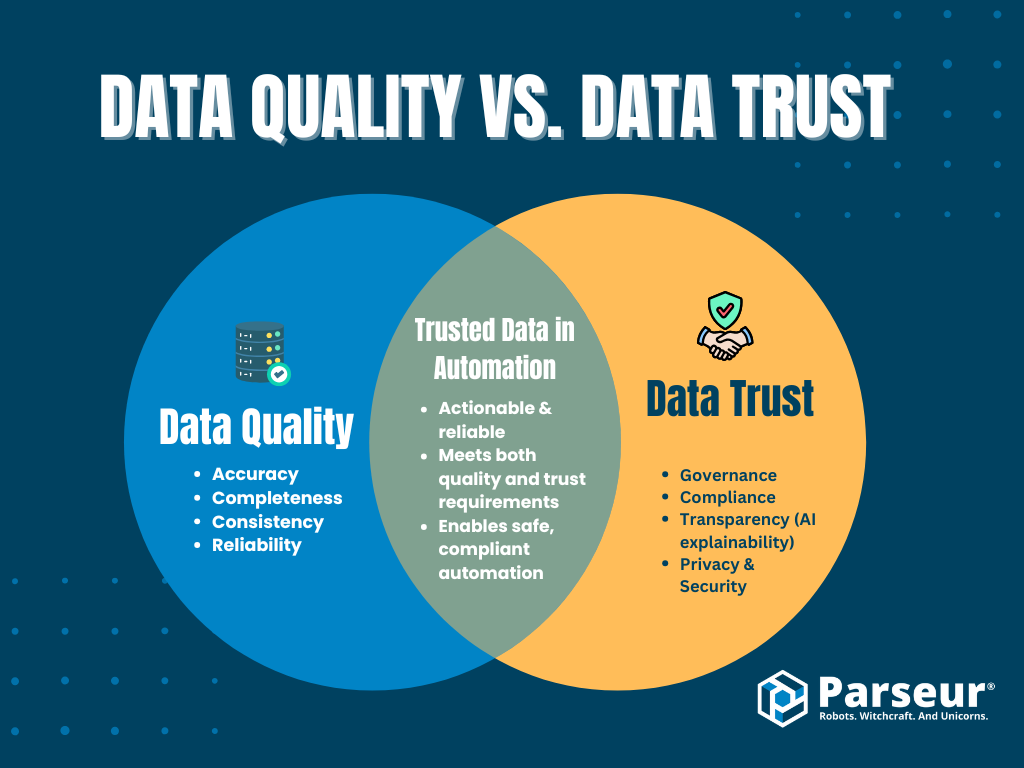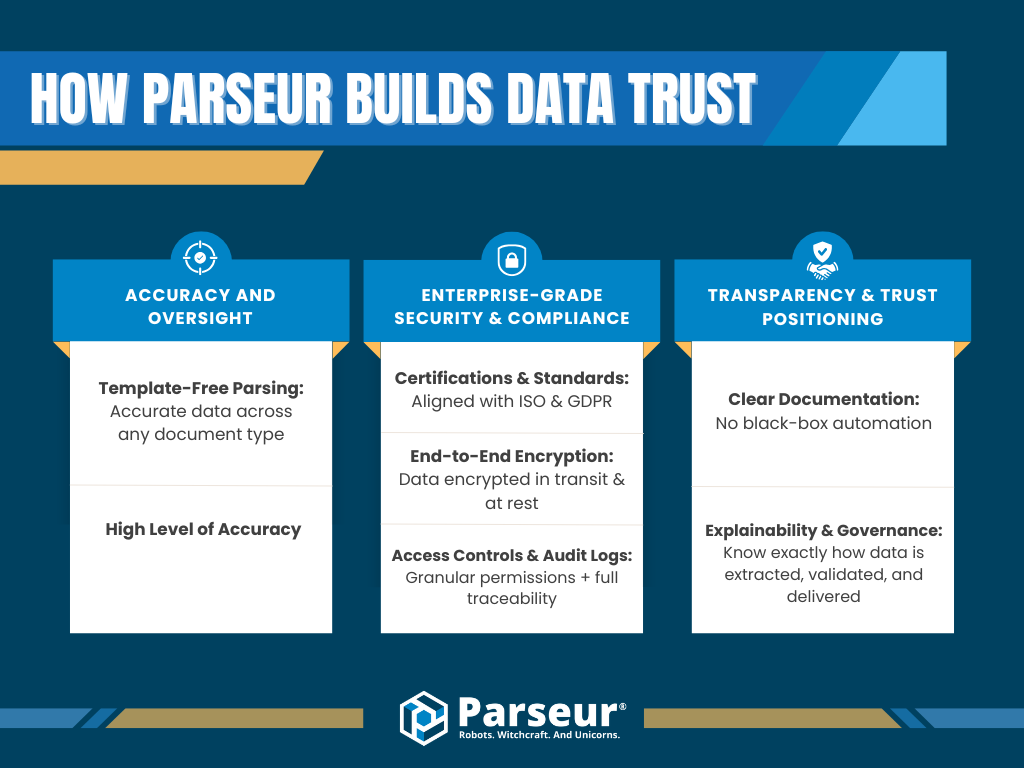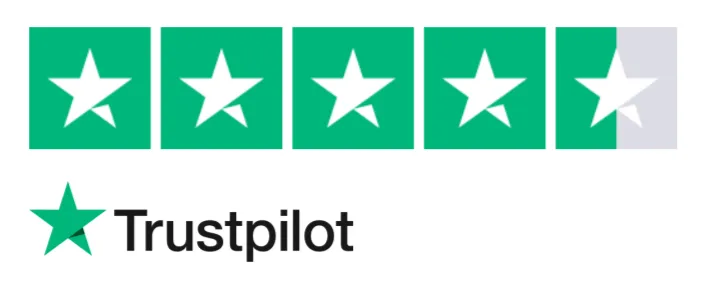What Is Data Trust?
Data trust refers to the confidence that the information used in automation is secure, compliant, transparent, and reliable for informed decision-making.
Key Takeaways:
- Data trust goes beyond accuracy; it includes governance, compliance, transparency, and security.
- Governance & compliance (GDPR, ISO, SOC) enable secure and can grow with demand automation.
- Parseur ensures trusted automation with enterprise-grade security and transparency.
In modern business, companies don’t just ask whether their data is accurate; they ask whether they can trust it. Trust goes beyond clean numbers; it’s about security, compliance, transparency, and the confidence that automation will act on data responsibly. Without trust, even the most advanced AI tools risk rejection, compliance penalties, or poor adoption.
This gap between ambition and adoption highlights a critical truth: organizations are eager to harness automation, but hesitation grows when data cannot be trusted. Accuracy alone isn’t enough; leaders need assurance that their systems handle information securely, comply with regulations, and remain transparent in making decisions.
According to Ataccama, in the year 2025, while 77% of organizations cite operational efficiency as their top strategic priority for AI-driven initiatives and 74% have adopted some AI-based approach, only 33% have successfully integrated AI across the enterprise, primarily due to lingering concerns about security and privacy.
Trust goes beyond clean numbers; it involves security, compliance, transparency, and the confidence that automation will act responsibly on data. According to Integrate, more than 64% of organizations cite data quality as the single biggest challenge for data integrity in 2025. With data volumes doubling every two years and 2 out of 3 companies reporting major data loss events last year, maintaining trust is both a technical and strategic hurdle.
Without trust, even the most advanced AI tools risk rejection, compliance penalties, or poor adoption. That’s why building data trust in automation is now a top priority for enterprises. Trust ensures sensitive information is handled securely, AI decisions are explainable, and workflows are accurate and compliant.
In this article, we’ll explore what data trust means in practice and how businesses can achieve it through frameworks like Trust Centers, human-in-the-loop (HITL) review, governance models, and compliance standards such as SOC and ISO. With 72% of data leaders convinced that failing to adopt trustworthy AI will cost them their competitive edge, effective trust-building is no longer optional in 2025, according to Ataccama.
What Is Data Trust?
Data trust refers to the confidence that the information used in automation is secure, compliant, transparent, and reliable for informed decision-making. Unlike data quality, which focuses on accuracy, completeness, and consistency, data trust also includes governance, privacy, and explainability.

- Data quality answers: “Is the data correct and usable?”
- Data trust answers: “Can we rely on this data to meet security, compliance, and ethical standards?”
For example:
- A customer record with a typo is a data quality issue.
- A customer record stored without encryption or proper consent is a data trust issue.
Both matter, but trust is the higher standard enterprises must uphold to scale automation responsibly.
Why Data Trust Is Critical In Document Processing?
In automation, data quality alone isn’t enough; organizations need trust in AI data. Without trust, even accurate data can create risk when scaled across critical workflows. According to Precisely, in 2025, 67% of organizations report they lack complete trust in the data used for automation and decision-making, even if that data appears accurate. Without trust, risks quickly escalate as AI scales across critical workflows.
The risks of untrusted data are significant:
- Compliance violations → In industries like finance and healthcare, one incorrect record can lead to regulatory fines or audit failures.
- Reputational damage → Sending a client the wrong invoice or misfiling a claim erodes confidence and credibility.
- Customer churn → When customers lose faith in the integrity of data-based processes, they take their business elsewhere.
This becomes even more urgent with the rise of large language models (LLMs) in document processing. LLMs rely on the data they’re fed; if that data isn’t trustworthy, outputs may be biased, misleading, or outright false. Establishing automation trust ensures that AI systems process documents efficiently and deliver compliant, secure, and transparent results.
In short: AI data trust is the foundation for safe, adaptable document automation.
Human-In-The-Loop (HITL) For Trust
No matter how advanced AI becomes, human monitoring remains essential for building data trust in automation. HITL ensures that critical decisions don’t rely solely on machines; they’re confirmed by people who can provide context, judgment, and accountability. In highly regulated industries, over 55% of companies have established formal AI governance boards to oversee and enforce HITL workflows in automation, as reported by Gartner.
How HITL builds trust:
- Oversight → Humans review edge cases or ambiguous data that automation may struggle with.
- Accountability → Sensitive tasks, such as financial approvals or healthcare record validation, include a human checkpoint to reduce compliance risks.
- Transparency → HITL workflows create clear audit trails, proving that decisions were reviewed and verified.
Case study examples:
- Insurance → Claims processing systems use automation to extract and verify key details, but agents review high-value or flagged claims before payouts, ensuring accuracy and regulatory compliance.
- Customer support → AI chatbots handle routine queries, while complex escalations are passed to human agents, ensuring customers never feel abandoned by an algorithm. By 2026, 70% of customer experience (CX) leaders plan to integrate Generative AI across touchpoints, using tools that often include HITL features to ensure quality and oversight, as mentioned by AmplifAI.
At Parseur, we position HITL as more than just a backup. It’s a human safety net built into automation, ensuring that businesses can scale while maintaining the highest levels of reliability and trust.
Governance, Compliance & Transparency
In the enterprise world, data trust in automation depends on more than accuracy; it requires rigorous AI governance and automation compliance. Organizations must prove their data practices are secure, ethical, and auditable at every step.
Key pillars of governance & compliance
- Regulatory frameworks → Standards like GDPR, ISO 27001, ensure that sensitive data is managed with privacy, security, and accountability in mind.
- Audit trails → Every automated decision or document extraction should leave a traceable record, enabling teams to verify what data was used, when, and by whom.
- Transparency & explainability → Trustworthy AI isn’t a black box. Clear documentation and explainable models help businesses demonstrate how outputs are generated.
- Standardization → Following frameworks like ECCMA (Electronic Commerce Code Management Association) ensures data interoperability, consistency, and reliability across systems and borders.
When automation platforms embed these principles, they don’t just reduce compliance risk; they actively build customer confidence and trust. In other words, governance and transparency aren’t roadblocks but enablers of secure, flexible automation.
How Parseur Builds Data Trust
Building data trust in automation isn’t just about extracting fields correctly; it’s about creating confidence that every piece of information is accurate, secure, and compliant. Parseur goes beyond traditional automation platforms by combining enterprise-grade security with transparent processes and human safety nets.

Enterprise-grade security & compliance
- Certifications & standards → Parseur aligns with leading frameworks like ISO and GDPR, ensuring that sensitive data is protected at every stage.
- End-to-end encryption → All data is encrypted in transit and at rest, safeguarding against breaches or unauthorized access.
- Access controls and audit logs → Granular permissions and detailed logs provide full traceability, making compliance audits easy to perform.
Accuracy and oversight
- Template-free parsing with validation → Ensures data accuracy across diverse document types, minimizing errors that competitors often overlook.
- Human-in-the-loop (HITL) → Offers additional oversight for edge cases, adding accountability and transparency where it matters most.
Transparency and trust positioning
Unlike competitors that operate as “black-box” automation tools, Parseur provides clear documentation, explainability, and governance support. Customers know exactly how data is extracted, confirmed, and delivered into their workflows.
Parseur helps businesses automate faster and with trust by prioritizing security, compliance, and transparency.
Essentially, data trust in automation is the foundation of successful AI adoption. Without trust, even the most advanced automation workflows risk breaking down, leading to compliance violations, operational inefficiencies, or customer churn.
Parseur is built to ensure accuracy, transparency, and compliance at every step. With enterprise-grade security, human-in-the-loop workflows, and alignment with global standards like GDPR, ISO, and ECCMA, Parseur gives businesses confidence that their data is not only processed but also processed with integrity.
Frequently Asked Questions
Building and maintaining data trust in automation often raises essential questions for organizations considering AI-driven document processing. Below, we’ve compiled answers to the most common concerns, from compliance and governance to the role of human oversight and Parseur’s approach to trust.
-
What is data trust in automation?
-
Data trust in automation is the confidence that automated systems handle data securely, accurately, and transparently, ensuring compliance, usability, and reliability for business decisions.
-
How is data trust different from data quality?
-
Data quality is about accuracy and consistency. Data trust goes further, covering governance, compliance, privacy, and transparency, ensuring that data is not only correct but also secure and auditable.
-
Why is human-in-the-loop (HITL) essential for trust?
-
HITL provides oversight and accountability, allowing humans to verify edge cases, prevent compliance issues, and maintain transparency in automated workflows.
-
How does Parseur support compliance?
-
Parseur aligns with major frameworks, such as GDPR, and ECCMA standards. To ensure regulatory compliance, it also offers audit trails, role-based access, and enterprise-grade data security.
-
Can automation without data trust harm businesses?
-
Yes. Without trust, automation can amplify errors, introduce compliance risks, damage reputation, and reduce customer confidence.
Last updated on




